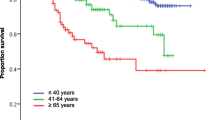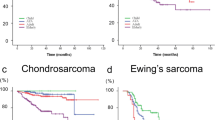Abstract
Objective
The aim of this study was to assess the differences in clinical appearance and prognosis of osteosarcoma between preadolescent and adolescent in Chinese patients and investigate whether age at diagnosis is a prognostic indicator.
Methods
Between May 2002 and May 2009, ninety-six children with high-grade osteosarcoma treated at our institute were stratified according to the age of 10. There were 19 preadolescents (≤ 10 years) and 77 adolescents (10 years < age ≤ 19 years), and their medical records were reviewed and compared using Fisher exact tests. Overall survival and disease- free survival was estimated by Kaplan-Meier methods and compared using log-rank tests. The prognostic significance of the various factors on survival was examined by Cox regression analysis.
Results
There were no significant differences in terms of Karnofsky Performance Status (KPS) score, Enneking stage, tumor location, histologic type, pathologic fracture, tumor necrosis rate, tumor size, relapse and frequencies of adjuvant chemotherapy between the two groups. A high proportion of preadolescent patients was treated with amputation (78.9% vs. 44.2%; P = 0.01). The 5-year survival of the preadolescent and adolescent groups was (38 ± 14)% and (33 ± 10)%, and the 2-year disease free survival for each group was (45 ± 12)% and (44.4 ± 6.3)%, respectively. Our study showed that age did not have any statistical significance for survival (P = 0.803). Univariate analysis indicated that KPS score; frequencies of adjuvant chemotherapy, tumor size and relapse were significantly related to overall survival. Multivariate Cox regression analysis revealed that both frequencies of adjuvant chemotherapy and relapse were independently prognostic factors for survival.
Conclusion
Clinical characteristics and survival between the preadolescents and adolescents with osteosarcoma in China were compatible. So we suggested that there did not need to treat preadolescents patients by alternative and/ or aggressive therapies compared with adolescent patients.
Similar content being viewed by others
References
Nagarajan R, Weigel BJ, Thompson RC, et al. Osteosarcoma in the first decade of life. Med Pediatr Oncol, 2003, 41: 480–483.
Rytting M, Pearson P, Raymond AK, et al. Osteosarcoma in preadolescent patients. Clin Orthop Relat Res, 2000, 373: 39–50.
Bacci G, Longhi A, Bertoni F, et al. Primary high-grade osteosarcoma: comparison between preadolescent and older patients. J Pediatr Hematol Oncol, 2005, 27: 129–134.
Cho WH, Lee SY, Song WS, et al. Osteosarcoma in preadolescent patients. J Int Med Res, 2006, 34: 676–681.
Bacci G, Balladelli A, Palmerini E, et al. Neoadjuvant chemotherapy for osteosarcoma of the extremities in preadolescent patients: the Rizzoli Institute experience. J Pediatr Hematol Oncol, 2008, 30: 908–912.
Harting MT, Lally KP, Andrassy RJ, et al. Age as a prognostic factor for patients with osteosarcoma: an analysis of 438 patients. J Cancer Res Clin Oncol, 2010, 136: 561–570.
Hsieh MY, Hung GY, Yen HJ, et al. Osteosarcoma in preadolescent patients: experience in a single institute in Taiwan. J Chin Med Assoc, 2009, 72: 455–461.
Lee JA, Kim DH, Lim JS, et al. The survival of osteosarcoma patients 10 years old or younger is not worse than the survival of older patients: a retrospective analysis. Cancer Res Treat, 2007, 39: 160–164.
Bielack SS, Kempf-Bielack B, Delling G, et al. Prognostic factors in high-grade osteosarcoma of the extremities or trunk: an analysis of 1,702 patients treated on neoadjuvant cooperative osteosarcoma study group protocols. J Clin Oncol, 2002, 20: 776–790.
Grimer RJ, Cannon SR, Taminiau AM, et al. Osteosarcoma over the age of forty. Eur J Cancer, 2003, 39: 157–163.
Kager L, Zoubek A, Pötschger U, et al. Primary metastatic osteosarcoma: presentation and outcome of patients treated on neoadjuvant Cooperative Osteosarcoma Study Group protocols. J Clin Oncol, 2003, 21: 2011–2018.
Scranton PE Jr, DeCicco FA, Totten RS, et al. Prognostic factors in osteosarcoma: A review of 20 years at the University of Pittsburg Health Center Hospitals. Cancer, 1975, 36: 2179–2191.
Winkler K, Beron G, Kotz R, et al. Neoadjuvant chemotherapy for osteogenic sarcoma: results of a Cooperative German/Austrian study. J Clin Oncol, 1984, 2: 617–624.
French Bone Tumor Study Group. Age and dose of chemotherapy as major prognostic factors in a trial of adjuvant therapy of osteosarcoma combining two alternating drug combinations and early prophylactic lung irradiation. Cancer, 1988, 61: 1304–1311.
Worch J, Matthay KK, Neuhaus J, et al. Osteosarcoma in children 5 years of age or younger at initial diagnosis. Pediatr Blood Cancer, 2010, 55: 285–289.
Picci P, Bacci G, Campanacci M, et al. Histologic evaluation of necrosis in osteosarcoma induced by chemotherapy. Regional mapping of viable and nonviable tumor. Cancer, 1985, 56: 1515–1521.
Author information
Authors and Affiliations
Corresponding author
Additional information
Supported by grants from the National Natural Science Foundation of China (No. of China (No. 81001191) and Science and Technology Commission of Shanghai (No. 10PJ1408300).
Rights and permissions
About this article
Cite this article
Qi, W., Shen, Z., Tang, L. et al. Comparison between preadolescent and adolescent patients with high-grade osteosarcoma in China. Chin. -Ger. J. Clin. Oncol. 11, 274–278 (2012). https://doi.org/10.1007/s10330-012-0965-1
Received:
Revised:
Accepted:
Published:
Issue Date:
DOI: https://doi.org/10.1007/s10330-012-0965-1




